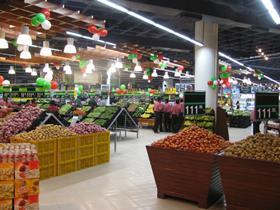
Despite being one of the world’s largest fresh fruit and vegetable producers and a significant importer, India’s fresh produce consumption is lagging well below the World Health Organisation (WHO) recommended levels across all income groups.
That’s one of the key findings of a new report published by the Delhi-based non-profit think-tank The Indian Council for Research on International Economic Relations (ICRIER).
‘India’s Phytonutrient Report: A Snapshot of Fruits and Vegetables Consumption, Availability and Implications of Phytonutrient Intake’ analysed fresh fruit and vegetable consumption patterns across the country, compared them to WHO recommended levels and examined the reasons for the shortfall.
The report is based on the results of a survey of 1,001 individuals drawn from upper and middle income households across five cities: the National Capital Region (New Delhi, Noida and Gurgaon), Mumbai, Chennai, Hyderabad and Kolkata. The respondents were all above 18 years of age, split 58/42 between male and female. Trained investigators conducted face-to-face interviews using a semi-structured questionnaire and recall methodology.
Diet skewed to cereals
The report highlighted how India is one of the world’s largest producers of fruit and vegetables and one of the largest consumer markets. Close to a third of its total private final consumption expenditure goes on food and beverage combined – compared with only 9 per cent in the United States, it said. However, fruit and vegetables make up only 9 per cent of total calorie intake in India, where the food basket is still heavily dominated by cereals and pulses.
Indeed, the survey confirmed that India’s fresh fruit and vegetable consumption is lagging well below the World Health Organisation recommended-levels, which call for a minimum daily intake of 400g of fruit and vegetables (or five daily servings with an average size of 80g), excluding potatoes, cassava and other starchy tubers.
The survey results revealed an average intake of fruit and vegetables of 3.5 servings a day, comprising 1.5 servings of fruit and 2 servings of vegetables.
The average intake for the younger generation came out even lower – with 18-24 year olds eating 2.97 servings per and 18-35 year olds consuming 3.3 servings per day. Housewives performed better, with an average intake of 3.65 servings per day compared to the working person’s 3.5 servings.
The survey found that income plays an important role, with average daily intake higher among higher income groups. Consumption levels also varied from city to city, with Chennai notching the highest levels of 4.35 servings per day and Kolkata registering the lowest (2.81 servings per day).
Consumption constraints
Lifestyle (51.1 per cent) emerged as the foremost reason for survey respondents’ poor consumption levels, particularly among the younger cohort and consumers in the National Capital Region. Seasonal availability (25.7 per cent) and high or variable pricing (20.6 per cent) also registered as key constraints to consumption.
Nevertheless, the report suggested there was good potential to grow consumption, pointing out that availability of fresh fruit and vegetables was only likely to increase
“It is likely that with liberalisation, globalisation and easting of trade restrictions, different types of fresh and processed food will be more readily available in the country,” said India’s Phytonutrient Report. “Today fruits and vegetables are available in different forms (such as fresh, frozen, juices and chopped), through multiple channels and in different formats (such as branded, non-branded, organic and inorganic).”
Liberalisation and education key
Mapping a way forward, the ICRIER made a number of policy recommendations on the back of the report. Some of these focused on farming and the supply chain in India, such as establishing traceability back to the farm to ensure that hygiene and quality standards are maintained, capacity building with Indian farmers, and easing restrictions on contract farming to attract farm-level investments. The report also suggested removing restrictions on inter-state movement of fruit and vegetables and considering liberalising foreign direct investment in multi-brand retail.
The recommendations also identified much work to be done at consumer level. Building awareness of the recommended daily intake of fruit and vegetables and associated health benefits was seen as a priority, particularly among younger consumers. The authors also called for store and non-store retail formats to be covered under consumer protection regulations.
“While consumption decisions are personal, the government, through appropriate policy, can support the desired consumption of fruit and vegetables, which, in turn, will help build a healthy nation,” said the report. “Most importantly, government policy has to protect the interests of consumers and provide them with a broader choice in terms of product variety and retail formats.”
Announcing the launch of the report on its website, the ICRIER said: “In India, the policy focus has been on malnutrition among poor. While this should continue to be the focus, a developing country with an abundant young and educated workforce in middle- to high-income groups also should focus on the health of its youth.”






No comments yet